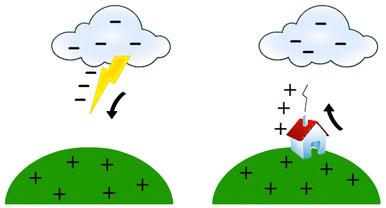| Lightning is a bright flash of electricity produced by a thunderstorm. All thunderstorms produce lightning and are very dangerous. It is a big charge of electricity that can reach from clouds to the ground or to other clouds. It can start fires and it is strong enough to hurt or kill people. |
| Thunderstorms contain very strong electrical charges. As the thunderstrom develops, motion of water droplets creates a strong positive charge on the ground and a strong negative charge on the bottom of the cloud. Since opposites attract, it causes a positive charge to build up on the ground beneath the cloud. The ground electrical charges around anything that sticks up, such as mountains, people, or single trees. The charge coming up from these points eventually connects with a charge reaching down from the clouds and then lightning strikes! |
|
 |
|
| In 1753, Benjamin FRANKLIN invented the lightning conductor. He was the first to demonstrate the electrical nature of lightning with his now famous <<kite experiment>>. Lightning rods are dedicated to the protection of structures against direct lightning strikes and then to conduct the lightning current safely to the ground (through the down conductors and the earthing system). |
|
| Lightning can strike anywhere on Mother Earth! Thousands of homes and other properties are damages and destroyed by lightning each year. The damages will be very severe when there is no lightning protection system present. A guide for the protection of persons and property from hazards arising from exposure to lightning can be found in the Code of Practice for Lightning Protection (CP 33 : 1996). |
|
 |
|
| Generally, lightning will strike the highest point of any structure or facility. A lightning protection system does not prevent lightning from striking; it provides a means for preventing damage byproviding a low resistance path for the discharge of lightning energy. An air terminal is used to capture the lightning strike to a preferred point so that the discharge current can be safely directed by means of a down conductor(s) to the ground. The down conductor provides a low impedance path from the air terminal to the ground so that lightning can be safety conducted to the earth,without causing excessive large voltages. |
|
 |
|
| |
| |





